Pickleball is all the rage, and today I want to talk about how the growth of the sport is becoming much more noticeable in real estate listings. I also have an interview with a friend who built a pickleball court in his backyard. For the record, I actually don’t play (yet), but a friend is trying to convert me. I’m just fascinated with how I see pickleball fitting into real estate.
Thank you Kelli, Darcia, & Dara for letting me use the photo above.
UPCOMING (PUBLIC) SPEAKING GIGS:
6/07/23 SAFE Credit Union event for agents (sold out)
6/08/23 Made 4 More event (in-person & Zoom)
7/20/23 SAR Market Update (in-person & livestream)
10/23 SAR Think Like an Appraiser (TBD)
EXPLOSIVE GROWTH SHOWING UP IN LISTINGS:
Pickleball has grown exponentially as a sport, and we’re seeing that reflected in real estate listings in the Sacramento region. The sport has been mentioned nearly 900 times in real estate listings through the years. Last week I tweeted that pickleball has been brought up 480 times, but it turns out it’s important to search “pickleball” and “pickle ball” in MLS to capture the full picture. By the way, pickleball is the correct spelling. It’s a compound word like basketball, baseball, and football. It looks like 2023 is going to outpace previous years, which is impressive since sales volume has been down substantially this year.

Do you see the growth? Here’s a different way to look at the same data, but with individual sales. There are two properties above $4M, but they were excluded as outliers. One of these units is pending at $4.3M in Loomis, and it has a pickleball court in the backyard.
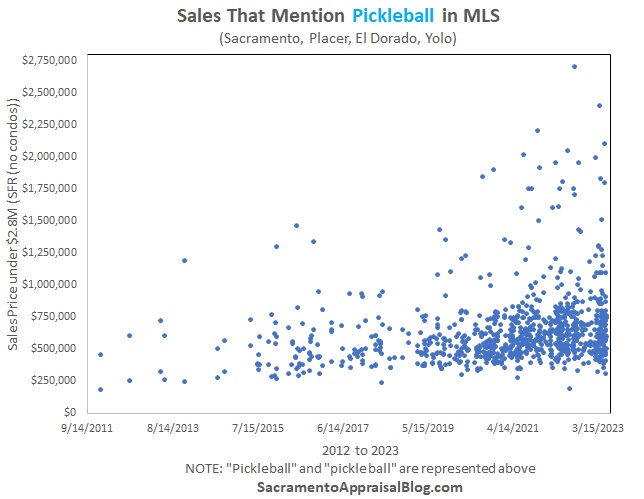
TAKEAWAYS:
This sport is clearly being mentioned more often, which is a reflection of neighborhoods being built with pickleball courts, local tennis courts being converted to pickleball courts (sorry tennis friends), and the real estate community recognizing the sport as an amenity for buyers. Neighborhoods like Sun City Lincoln Hills, Sun City Roseville, and McKinley Village all have pickleball courts. Oh, and once in a while there are homes with backyard courts, but that’s not too common.
AN INTERVIEW: A BACKYARD PICKLEBALL COURT
 Okay, now an interview with Jacob Brewster. He’s an appraiser colleague in Utah, and I’ve known him for a number of years. I thought Jacob’s story would be really interesting to share.
Okay, now an interview with Jacob Brewster. He’s an appraiser colleague in Utah, and I’ve known him for a number of years. I thought Jacob’s story would be really interesting to share.
Ryan: Why did you build a pickleball court in your backyard?
Jacob: I’ll get to that, but first I want to say I’m disappointed you’re not a pickleball player yet.
Ryan: Haha. Yeah, a friend is working on me. I’m pretty sure I’m going to convert at some point to the pickleball religion.
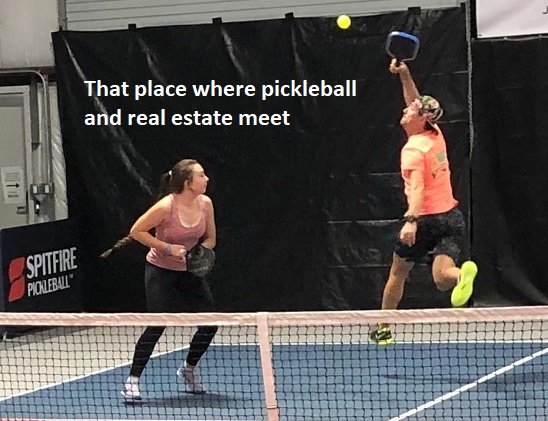
Jacob: That sounds good. Anyway, I started playing pickleball casually during the COVID shutdowns in 2020. Pickleball is incredibly fun, social, active, competitive, and addicting. I started playing more competitively, playing in tournaments and competitions, and traveling to play. I wanted to get better and better. With the explosive growth of pickleball, finding an open public court became increasingly more difficult. Going from park to park only to find all the courts taken up was not uncommon. I decided that not only do I want to play whenever I want (and not fight over courts), I also want to drill and practice at will. A home court was the best solution. Notice I didn’t say I wanted to build a court to increase my property’s value. This was a very personal decision.
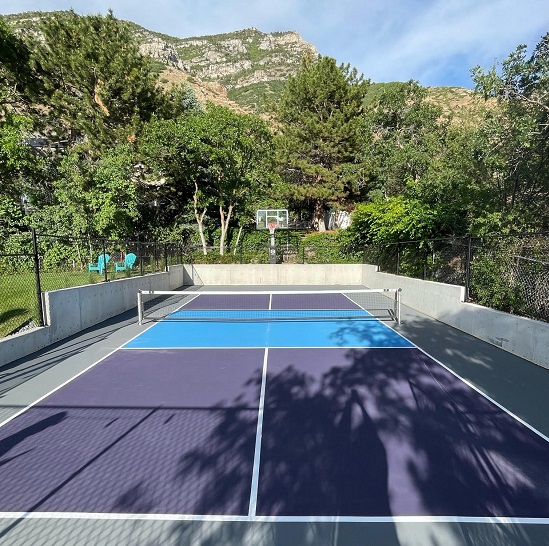
Ryan: Why do you think this sport is growing so much?
Jacob: Any Google search will show pickleball is the fastest growing sport in the United States. It’s growing at an exponential rate right now. Builders are putting pickleball courts into just about every new residential development or new tract in Utah. Pickleball is a sport for all ages. Everyone hears the story of the young, fit college kid who goes to the local park and sees pickleball for the first time ever being played by a bunch of old grandparents, and thinks they could whip them, but the old people whip up on the kid. Pickleball used to have a reputation of being an old person’s sport. However, the best female player in the world (making well into 6 figures on the pro tour) is just 16 years old, and she’s been the best since she was 14. Although she’s a bit of a phenom, it just goes to show how young people can be really good at this sport. As the sport has grown, more and more professional tennis players have made the transition over to pickleball. It’s easy to learn, but incredibly difficult to master. The barrier to entry is almost none – if you can hold a paddle and hit a ball and walk around a court, you can play pickleball. It’s incredibly addicting! The ‘shots’ as they’re called in pickleball can be quite entertaining and funny to begin with. There’s a lot of laughter on the court at the lower levels. It’s very social – a pickleball court is just 44′ in length, so all players are typically pretty close to each other and within ear shot, either talking casually as they’re playing or talking trash in more competitive games.
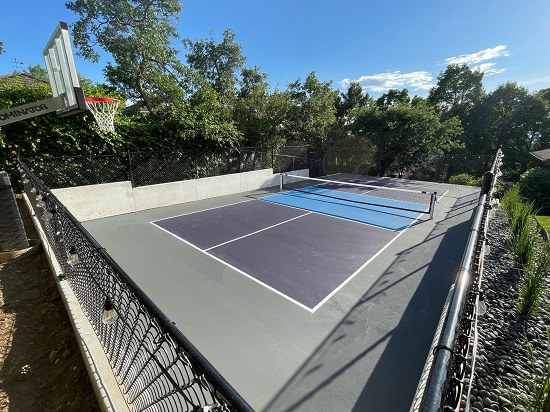
Ryan: What advice would you give for building a backyard court?
Jacob: Take your time to think about and plan everything. Don’t rush into it. Don’t let contractors push you one way or another, and don’t let contractors rush their job. They will naturally want to do what’s in their own best interest, or easiest for them, not necessarily what’s best for your situation. There’s a lot to plan with a court – where do you want it on your lot, which direction (courts are traditionally situated North-South, but in some cases that’s not possible), can you do post-tension or do you need stress cracks, do you want permanent posts or a temporary/movable net, will your court be a multi-sport court (like basketball too), will you need fencing and what type, will you need lighting and how much, etc. In my experience, building a pickleball court was just like any other home improvement in this sense: It definitely cost a lot more than we planned or budgeted for. A lot more!!! And our concrete contractor wasn’t concerned about my wants or desires or other contractors like fencing or lighting, so our end-result was not 100% what I envisioned or wanted. We are ultimately happy with it, but there are definitely things we would have done differently.
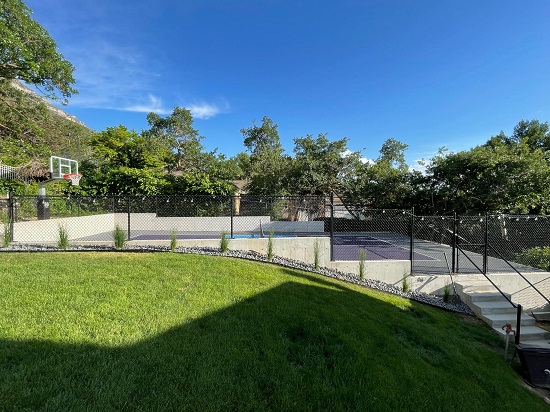
Ryan: I have to ask. How much did it cost?
Jacob: As an appraiser I cringe at the amount of money I spent on my court, knowing full well that my property value will not recoup close to what I spent. But that’s okay – again, it was a very PERSONAL decision. Sometimes homeowners ask me at inspections whether they should build a swimming pool, solar, a deck, a sports court, or (fill in the blank). My response is often the same – you guys do what YOU want, it’s a personal decision. Primary residences are meant to be enjoyed, so do what brings you joy. Return on investment is just one measurable, but it can’t indicate how much you’ll use the item, or the memories you’ll share around that thing. My lot was not level, it was rolling. We had to do a lot of landscape leveling (brought one section down 4′ and brought one section up 4′) and because of that we required a 180′ retaining wall 8″ thick all the way around the perimeter of my court. The retaining wall cost more than the slab of my 60×30 court. After all was said and done, the earth movement, retaining wall, slab for the court, fencing, posts/net, professional grade paint – I’m in this about $95,000. And I haven’t done lighting yet (current bid is another $21,000), that will have to wait.

Ryan: How would you approach valuing this as an appraiser?
Jacob: Valuing something like this can be tricky. Not all pickleball courts are created equal. Some have extensive lighting, some have a permanent net/post, while others have temporary. Some don’t even do professional grade paint but instead just stick with concrete or lay down temporary mats/tiles. To me, it’s a little bit like valuing a pool. I used to live in California where pools were very common, but not all pools were exactly the same. Some would cost $200,000 to build and others were a small fraction of that cost with just the basics. Do those two pools contribute the same? Paired sales analysis is preferable, but often results can be quite subjective because finding two highly similar homes where one has a court can prove quite difficult. Another method can be cost-less-depreciation where depreciation not only accounts for physical depreciation but also functional obsolescence. For example, if we can find other auxiliary items of contributory value such as a swimming pool, a detached guest house, a shop, or something of that nature and arrive at a reasonable discount, we can apply that discount to the sports court (where no sports courts comps are to be found). I always like to support my adjustments through anecdotal interviews with local knowledgeable real estate agents/brokers too. While this info is not statistical, a knowledgeable agent/broker typically has a good grasp on what auxiliary features might contribute or in other words what the market might be willing to pay/offer/accept above a comparable property without that same feature.
Ryan: Anything else to add?
Jacob: Remember that if this is your personal residence, make decisions that will make you happy! Homes are to be enjoyed, where memories are made! However, part of the conversation should include “how long do I plan on living here?” If you plan on moving in the next 1-3 years, taking a $50,000 hit because that sports court you want might not be the right decision right now. But if you’re in your forever home, by all means do what makes you happy!!!
Ryan: Thank you for doing the interview. I appreciate the time you took to share thoughts. Everyone, please connect with Jacob.
CLOSING THOUGHTS
I had fun with this post, and I hope you enjoyed it. Last week I got curious about how the sport was showing up in real estate listings, and the data nerd in me had to explore this and find a way to visualize the trend.
MARKET STATS: I’ll have lots of market stats out this week on my social channels, so watch Twitter, Instagram, LinkedIn, and Facebook.
Thanks for being here.
Questions: Is close proximity to a pickleball court something on your mind as a buyer or real estate professional? Would you ever build a court of any kind in your backyard? Why or why not?
If you liked this post, subscribe by email (or RSS). Thanks for being here.
Read the full article here









